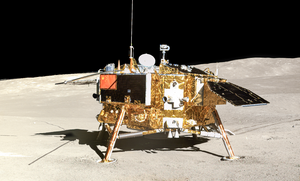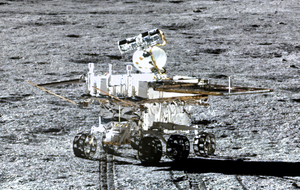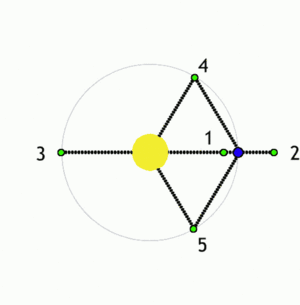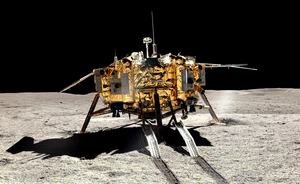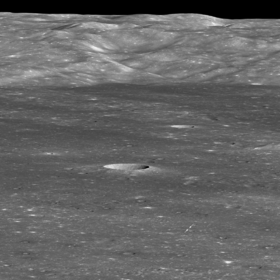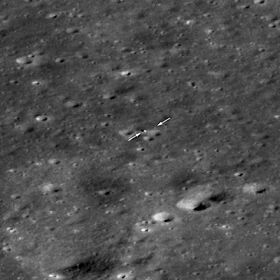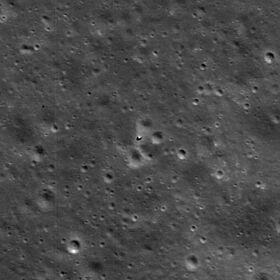Chang'e 4 facts for kids
|
Top: Chang'e 4 lander on the surface of the Moon
Bottom: Yutu-2 rover on lunar surface. |
|
| Mission type | Lander, lunar rover |
|---|---|
| Operator | CNSA |
| Mission duration | Lander: 12 months (planned) 7 years, 5 days (in progress) Rover: 3 months (planned) 7 years, 5 days (in progress) |
| Spacecraft properties | |
| Launch mass | Total: 3,780 kg Lander: 3,640 kg Rover: 140 kg |
| Landing mass | Total: ~1,200 kg; rover: 140 kg |
| Dimensions | Rover: 1.5 × 1.0 × 1.0 m |
| Start of mission | |
| Launch date | 7 December 2018, 18:23 UTC |
| Rocket | Long March 3B |
| Launch site | Xichang Satellite Launch Center, LA-2 |
| Lunar lander | |
| Landing date | 3 January 2019, 02:26 UTC |
| Landing site | Von Kármán crater in the South Pole-Aitken Basin 45°26′38″S 177°35′56″E / 45.444°S 177.599°E |
| Lunar rover | |
| Landing date | 3 January 2019, 02:26 UTC |
| Landing site | Von Kármán crater in the South Pole-Aitken Basin |
| Distance covered | 1.596 km (0.992 mi) as of 4 May 2024[update] |
|
Chinese Lunar Exploration Program
|
|
Chang'e 4 (Chinese: 嫦娥四号; pinyin: Cháng'é Sìhào; literally "Chang'e No. 4") is a robotic spacecraft mission. It is part of China's Chinese Lunar Exploration Program. On January 3, 2019, China made history. It achieved the first-ever soft landing on the far side of the Moon.
To make this possible, a special communication relay satellite called Queqiao was launched first. This happened in May 2018. It orbits a special point in space where it can see both Earth and the Moon's far side. The Chang'e 4 lander and its Yutu-2 (Chinese: 玉兔二号; pinyin: Yùtù Èrhào; literally "Jade Rabbit No. 2") rover launched on December 7, 2018. They landed on the Moon's far side on January 3, 2019.
A cool experiment on the lander had seeds sprout. This was the first time plants grew on the Moon! The mission is a follow-up to Chang'e 3, which was China's first Moon landing. Chang'e 4 was actually built as a backup for Chang'e 3. But after Chang'e 3 landed safely, Chang'e 4 was updated for new goals. Like other Chinese Moon missions, it's named after Chang'e, the Chinese Moon goddess.
In 2019 and 2020, the Chang'e 4 team received big awards. These included the Gold Medal from the Royal Aeronautical Society. They also got the World Space Award. These were the first times a Chinese mission won such honors.
Contents
Exploring the Moon's Far Side
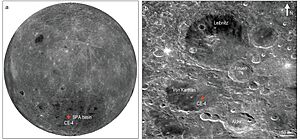
The Chinese Lunar Exploration Program has several steps. First, they send spacecraft to orbit the Moon. Chang'e 1 and Chang'e 2 did this. The second step is landing on the Moon and using a rover. Chang'e 3 and Chang'e 4 completed this. The third step is bringing Moon samples back to Earth. Chang'e 5 did this in 2020. Chang'e 6 will try this in the future.
The program also plans to build a robotic research station. This station would be near the Moon's south pole. China hopes to send people to the Moon in the 2030s. They might even build an outpost there.
The Chang'e 4 mission helps us learn about an unknown part of the Moon. It also helps develop new technologies. These technologies are important for future space missions.
The lander touched down at 02:26 UTC on January 3, 2019. It was the first spacecraft to land on the Moon's far side. The Yutu-2 rover was then released about 12 hours later.
Launch and Landing
The Chang'e 4 mission was first planned for 2015. But changes to its goals and design caused delays. It finally launched on December 7, 2018, at 18:23 UTC.
The spacecraft entered the Moon's orbit on December 12, 2018. Its orbit was lowered on December 30, 2018. The landing happened on January 3, 2019. It landed in the Von Kármán crater. This crater is inside the huge South Pole-Aitken basin.
What Chang'e 4 Hopes to Find
An ancient impact on the Moon created a giant crater. It's called the Aitken Basin. This basin is about 13 kilometers (8 miles) deep. Scientists think the impact might have exposed deep layers of the Moon. These layers include the crust and possibly the mantle.
If Chang'e 4 can study these materials, it would teach us a lot. We could learn about the Moon's inside and how it formed.
The main goals of the mission are:
- Measure the chemicals in Moon rocks and soils.
- Check the Moon's surface temperature over time.
- Use a radio telescope to study low-frequency radio waves from space.
- Learn about cosmic rays.
- Observe the solar corona (the Sun's outer atmosphere). This helps us understand solar storms.
Mission Parts
The Chang'e 4 mission uses several important parts. These include a relay satellite, small microsatellites, and the lander and rover.
Queqiao Relay Satellite
Talking directly to Earth from the Moon's far side is impossible. The Moon itself blocks the signals. So, a relay satellite is needed. This satellite sits in a spot where it can see both the landing site and Earth.
China launched the Queqiao (Chinese: 鹊桥; pinyin: Quèqiáo; literally "Magpie Bridge") relay satellite on May 20, 2018. It orbits a special point called the Earth–Moon L2 point. The satellite weighs about 425 kg (937 lb). It uses a large antenna to send signals between the lander/rover and Earth.
The satellite took 24 days to reach its orbit. It used the Moon's gravity to save fuel. On June 14, 2018, Queqiao entered its final orbit. This was the first lunar relay satellite at this spot. The name Queqiao comes from an old Chinese tale.
Longjiang Microsatellites
Two small satellites, Longjiang-1 and Longjiang-2 (Chinese: 龙江; pinyin: Lóng Jiāng; literally "Dragon River"), were launched with Queqiao. Each weighed about 45 kg (99 lb). They were built by the Harbin Institute of Technology in China. Longjiang-1 didn't reach lunar orbit. But Longjiang-2 did and worked until July 2019. It was then guided to crash onto the Moon.
These microsatellites were meant to study the sky. They looked for very low-frequency radio waves. These waves are hard to study from Earth because of our atmosphere. This research could lead to new discoveries about space.
Chang'e Lander and Yutu-2 Rover
The Chang'e 4 lander and Yutu-2 rover look like Chang'e 3 and its Yutu rover. Chang'e 4 was a backup for Chang'e 3. But it was changed to fit its new mission goals. The lander and rover launched on December 7, 2018.
The total landing weight was about 1,200 kg (2,600 lb). Both the lander and the Yutu-2 rover have special heaters. These heaters keep them warm during the long, cold lunar nights. Solar panels provide their electricity.
After landing, the lander lowered a ramp. The Yutu-2 rover then rolled onto the Moon's surface. The rover is about 1.5 meters (4.9 ft) long. It weighs 140 kg (309 lb). Yutu-2 is powered by the sun and has six wheels. It was designed to work for three months. But engineers hoped it would last longer. On November 21, 2019, Yutu 2 broke a record. It became the longest-working lunar rover, passing the Soviet Union's Lunokhod 1.
Science Experiments
The relay satellite, microsatellite, lander, and rover all carry science tools. The relay satellite studies radio waves. The lander and rover study the Moon's surface. Some tools were provided by other countries. These include Sweden, Germany, the Netherlands, and Saudi Arabia.
Relay Satellite Experiments
The main job of the Queqiao relay satellite is to send messages. It connects Earth with the lander on the Moon's far side.
Besides its main job, Queqiao also has a tool called NCLE. This tool studies radio waves from space. It helps scientists learn about the universe in a new way.
Lunar Lander Experiments
The lander has tools to study the Moon's surface. It also has a special experiment about life.
- Landing Camera (LCAM): This camera recorded video as the lander came down.
- Terrain Camera (TCAM): This camera takes high-quality pictures of the Moon's surface. It can also photograph the rover.
- Low Frequency Spectrometer (LFS): This tool studies radio bursts from the Sun. It also looks at the Moon's atmosphere.
- Lunar Lander Neutrons and Dosimetry (LND): This tool measures radiation on the Moon. It helps us understand how much radiation future astronauts might face. It showed that radiation on the Moon is much higher than on the ISS.
- Lunar Micro Ecosystem: This was a small, sealed container. It had seeds and insect eggs inside. The goal was to see if plants and insects could grow together on the Moon. It included cottonseed, potato, rapeseed, and a flowering plant. It also had yeast and fruit fly eggs. The container tried to keep conditions like Earth's.
- Result: The experiment started on January 3, 2019. Cottonseed, rapeseed, and potato seeds sprouted. But the experiment ended early on January 16. The temperature dropped too low during the lunar night. Even though it was short, it gave valuable information.
Lunar Rover Experiments
The Yutu-2 rover also has several science tools:
- Panoramic Camera (PCAM): This camera takes 3D pictures of the Moon's surface. It helps scientists see the landscape.
- Lunar Penetrating Radar (LPR): This radar can look deep under the Moon's surface. It can see up to 100 meters (330 ft) down.
- Visible and Near-Infrared Imaging Spectrometer (VNIS): This tool identifies materials on the surface. It uses light to figure out what rocks and soil are made of.
- Advanced Small Analyzer for Neutrals (ASAN): This tool studies how solar wind affects the Moon's surface. This could help explain how lunar water forms.
Mission Cost
The cost of the Chang'e 4 mission was not given as an exact number. A project leader said it was "close to building one kilometer of subway." Building a kilometer of subway in China can cost between 500 million and 1.2 billion yuan. That's about US$72 million to US$172 million.
Landing Spot
The Chang'e 4 lander touched down in the Von Kármán crater. This crater is about 180 km (110 miles) wide. It's located in the South Pole-Aitken Basin on the Moon's far side. No lander had explored this area before.
The landing site has special meaning. Theodore von Kármán was a teacher to Qian Xuesen. Qian Xuesen is known as the founder of the Chinese space program.
The lander touched down at 02:26 UTC on January 3, 2019. It was the first spacecraft to land on the Moon's far side. The Yutu-2 rover was deployed about 12 hours later.
The exact spot where it landed is 45.4446°S, 177.5991°E. This landing site was later named Statio Tianhe. Four other Moon features were also named during this mission. These include a mountain (Mons Tai) and three craters.
What the Mission Found
A few days after landing, Yutu-2 went into "sleep mode" for its first lunar night. It woke up on January 29, 2019, and all its tools were working. During its first full lunar day, the rover traveled 120 meters (390 ft).
In May 2019, scientists reported an exciting discovery. Chang'e 4 found what seem to be rocks from the Moon's mantle. This was a main goal of the mission.
In January 2020, China shared a lot of data and images from the mission. In February 2020, Chinese scientists reported a detailed image of Moon material. This was based on data from the Lunar Penetrating Radar on Yutu-2. It helped them study the Moon's inside.
Working with Other Countries
Chang'e 4 was the first big space project between the United States and China since 2011. Scientists from both countries talked regularly before the landing. They discussed how to observe the landing. NASA's Lunar Reconnaissance Orbiter (LRO) was not in the right place to see it. But American scientists told China about their satellites. China shared the landing location and time with American scientists.
China also agreed to let NASA use Chang'e 4 and the Queqiao relay satellite for future American Moon missions.
International Reactions
NASA Administrator Jim Bridenstine congratulated China. He called the mission "an impressive accomplishment."
Martin Wieser, a scientist from Sweden who worked on one of the tools, was excited. He said, "We know the far side from orbital images... but we don't know it from the surface. It's uncharted territory and that makes it very exciting."
Gallery
- Images of Chang'e 4 landing site
Images for kids
See also
 In Spanish: Chang'e 4 para niños
In Spanish: Chang'e 4 para niños
- Animals in space
- Plants in space
- Closed ecological system
- Exploration of the Moon
- List of missions to the Moon
- Luna 3, the first spacecraft to image the lunar far side
- List of artificial objects on the Moon


